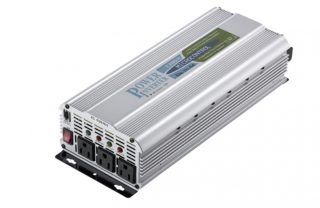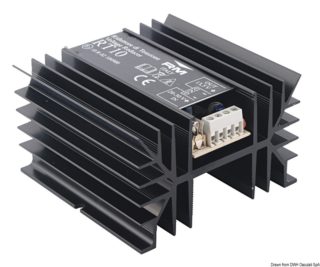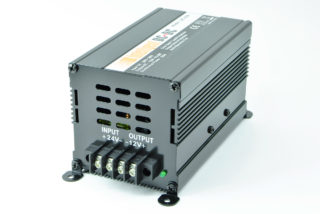Any voltage converter is an electrical or electronic device capable of changing its value by the required value. This device is especially in demand in situations when it is necessary to connect a load with different voltage ratings to the network. Moreover, they can not only lower the value of this parameter, but also increase it.
Principle of operation
The main requirement that determines the principle of operation of voltage converters is the ability to transfer useful power to the output with minimal losses (to ensure maximum efficiency). For this, they often use modules that are economical in terms of losses, for example, electronic inverters. An electric voltage converter built according to a transformer circuit is the most convenient for considering the principle of operation. The essence of its functioning is as follows:
- at the input of the device, the potential comes from an alternating voltage generator or a similar current source;
- a signal similar in shape is removed from the output of the transformer (from its secondary winding);
- if necessary, the alternating output voltage is first rectified by a special diode block, and then stabilized.
It is very difficult to achieve the desired efficiency from such a circuit, since part of the transmitted power is lost in the transformer windings (due to thermal dissipation).
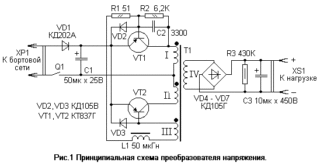 In order to obtain high efficiency from the device, key schemes operating in an economical mode are installed at the transformer output. When they work, based on the high-speed switching of transistors from closed to open, power losses in the windings are significantly reduced.
In order to obtain high efficiency from the device, key schemes operating in an economical mode are installed at the transformer output. When they work, based on the high-speed switching of transistors from closed to open, power losses in the windings are significantly reduced.
In voltage converters designed to work with high-voltage power sources, the phenomenon of self-induction is traditionally used. It is implemented in output ferrite cores with a sharp interruption of current in the primary winding. All the same transistors are used as such a chopper, and the pulse voltage received at the output is then rectified. Such schemes make it possible to obtain high potentials of the order of several tens of kV. They are used in power circuits of already outdated cathode ray tubes, as well as in television picture tubes. In this case, it is possible to obtain a good efficiency (up to 80%).
Areas of use
The scope of multi-zone voltage converters is very extensive. They are traditionally used for the following purposes:
- in linear devices for the distribution and transmission of electricity;
- for carrying out such critical technological operations as welding, heat treatment and the like;
- if necessary, power supply of load circuits in various fields of technology.
In the first case, the EMF generated at power plants is increased with the help of these devices from 6-24 kV to 110-220 kV - in this form it is easier to “distill” the wires over long distances. At district substations, other transformer devices already provide its reduction, first to 10 (6.3) kV, and then to the usual 380 Volts.
When servicing process equipment, voltage converters are used as electrothermal installations or welding transformers.
In industry
The most extensive area of application is to provide high-quality nutrition to the following industrial designs of consumers:
- equipment operating in automatic control and control lines;
- telecommunication and communication devices;
- a wide range of electrical measuring instruments;
- special radio and television equipment and the like.
A special function is performed by the so-called "isolation" transformers used to decouple the load lines from the high-voltage input.
Since such converters "play an auxiliary role", most often they have a small power and a relatively small size.
In everyday life, medicine and the defense industry
Voltage converters are widely used in everyday life. Based on them, most of the PSUs used to charge household appliances, as well as more complex devices such as:
- Surge Protectors;
- inverters;
- redundant power supplies, etc.
These devices are most in demand in medicine, the military sphere, as well as in energy and science. In these industries, they are particularly "stringent" requirements regarding the quality of the converted voltage ("purity" of the sinusoid, for example).
Advantages and disadvantages
The advantages of voltage converters include:
- the ability to control the parameters of the output signal - turning its variable into a constant value using the principle of frequency conversion;
- availability of the option of switching input and output circuits (variation in voltage amplitude);
- the permissibility of adjusting their nominal values to a specific load;
- compactness and simplicity of design of household converters, which are often made in a modular or wall-mounted design;
- profitability (according to the manufacturers, their efficiency reaches 90%);
- ease of use and versatility;
- the ability to transmit electricity over long distances and ensuring the operation of critical industries.
The disadvantages include high cost and low moisture resistance (with the exception of models designed specifically for use in high humidity).
Varieties of Converters
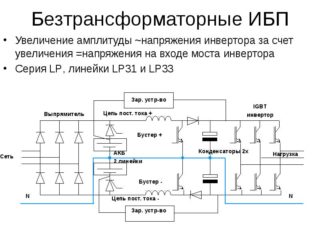 Among the whole variety of existing types of converters, the following classes stand out:
Among the whole variety of existing types of converters, the following classes stand out:
- special devices for the home;
- high voltage and high frequency equipment;
- transformerless and inverter pulse devices;
- DC / DC converters;
- adjustable devices.
To this category of electronic devices include current to voltage converters.
Home Appliances
An ordinary user is constantly faced with this type of converter devices, since most models of modern technology have a built-in power supply. The same class includes uninterruptible power supplies (UPS) with built-in battery.
In some cases, household converters are performed according to a double ring (inverter) circuit.
Due to this conversion from a direct current source (battery, for example), it is possible to obtain an alternating voltage of a standard value of 220 volts at the output. A feature of electronic circuits is the ability to obtain a purely sinusoidal signal of constant amplitude at the output.
Adjustable devices
These units are able to value the output voltage and increase it. In practice, devices are more common that allow you to smoothly change the lower value of the output potential.
The classic case is when 220 volts act on the input, and an adjustable constant voltage of 2 to 30 volts is obtained at the output.
Instruments with fine adjustment of the output parameter are traditionally used to test dial and digital measuring instruments in modern research laboratories.
Transformerless devices
Transformerless (inverter) units are built on an electronic principle, involving the use of a separate control module.They use a frequency converter as an intermediate link, which leads the output signal to a form convenient for rectification. In modern samples of inverter equipment, programmable microcontrollers are often installed that significantly improve the quality of conversion control.
High-voltage devices are represented by station transformers already described, which increase and decrease the transmitted voltage in the required proportions.
When transferring energy through high-voltage lines and subsequent transformation, they seek to minimize its losses in watts to a minimum.
The same class includes devices that form a signal for controlling the beam in a television tube (kinescope).
